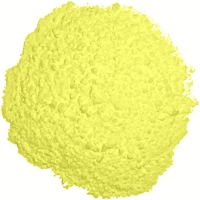Loading AI tools
Molecule used for pharmaceutical treatment of skin conditions From Wikipedia, the free encyclopedia
Sulfur is used in pharmaceutical skin preparations for the treatment of acne and other conditions. It acts as a keratolytic agent and also kills bacteria, fungi, scabies mites and other parasites.
 | |
| Clinical data | |
|---|---|
| AHFS/Drugs.com | Multum Consumer Information |
| Routes of administration | Topical, rarely oral |
| ATC code | |
| Legal status | |
| Legal status |
|
| Identifiers | |
| |
| CAS Number |
|
| PubChem CID | |
| ChemSpider | |
| UNII | |
| ChEBI | |
| Chemical and physical data | |
| Formula | S8 |
| Molar mass | 256.48 g·mol−1 |
| 3D model (JSmol) | |
| |
| |
Chemically, it is the naturally occurring octasulfur (S8).

Precipitated sulfur and colloidal sulfur are used, in form of lotions, creams, powders, soaps, and bath additives, for the treatment of acne vulgaris, acne rosacea, and seborrhoeic dermatitis.[1][2][3] Other topical uses included the treatment of superficial mycoses (infections with fungi) and scabies, but this is largely obsolete now.

Common adverse effects include irritation of the skin at the application site, such as dryness, stinging, itching and peeling.[4] Generalised allergic reactions are rare; they include hives as well as swelling of lips, tongue, and throat, potentially closing up the respiratory tract.[4]
Ingesting more than a few grams can lead to poisoning by hydrogen sulfide (H2S), which the gut flora produces from sulfur. H2S is also generated on the skin, but topical formulations do not induce toxic concentrations, except when large quantities are used for small children.[1]
Sulfur is converted to hydrogen sulfide through reduction, partly by bacteria. H2S kills bacteria (possibly including Propionibacterium acnes which plays a role in acne[2]), fungi, and parasites such as scabies mites. In the gut, H2S increases motility, acting as a laxative.[1] Sulfur's keratolytic action is also mediated by H2S; in this case, the hydrogen sulfide is produced by direct interaction with the target keratinocytes themselves.[5]
Seamless Wikipedia browsing. On steroids.
Every time you click a link to Wikipedia, Wiktionary or Wikiquote in your browser's search results, it will show the modern Wikiwand interface.
Wikiwand extension is a five stars, simple, with minimum permission required to keep your browsing private, safe and transparent.